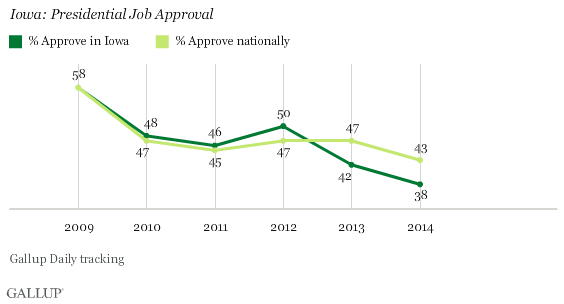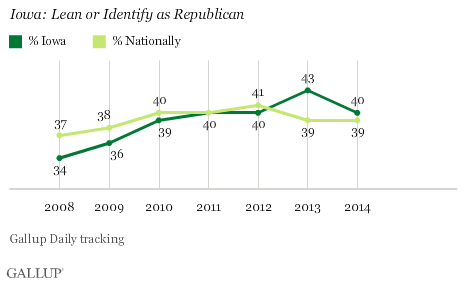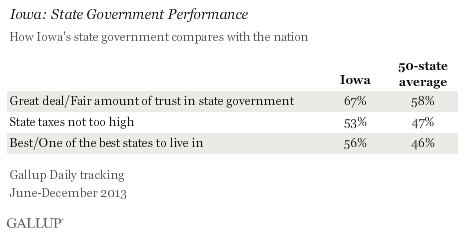WASHINGTON, D.C. -- As a key U.S. Senate race unfolds in Iowa, President Barack Obama's declining job approval rating may be one factor making it such a close battle. Obama's approval rating among Iowans for the first half of the year stood at 38%, five percentage points below the national average and the lowest rating Gallup has measured in Iowa during his presidency. The Senate race pits current Democratic Rep. Bruce Braley against Republican state Sen. Joni Ernst. Several polls show a close race -- perhaps closer than many analysts would expect, given Ernst's relatively unknown background as a new state senator versus Braley's background as a four-term U.S. Representative.

Perhaps more than any state other than Obama's home state of Illinois, Iowa has been important to the president's political career. His win in the 2008 Iowa caucus transformed him from a decided underdog to a contender for the Democratic nomination. He would go on to win this key swing state's Electoral College votes twice, in the 2008 and 2012 general elections.
 |
|
Discover how Americans rate their state in 2014, across key metrics
|
But despite the integral role the Hawkeye State has played in Obama's political career, Iowans could cause Obama a severe second-term setback if they elect a Republican to succeed retiring Democratic Sen. Tom Harkin. A GOP victory would help increase the chances for Republicans to take control of the Senate, hindering Obama's agenda for his remaining two years in office.
Further complicating matters for Braley is the surge in Republican identification in Iowa since 2008, as measured by self-reported party affiliation and independents who report "leaning" toward the GOP. While the percentage of national adults identifying as or leaning Republican was two percentage points higher in the first half of 2014 than in 2008 (39% vs. 37%, respectively), it was six points higher among Iowans (40% vs. 34%).

Meanwhile, in the first half of 2014, 41% of Iowans said they identify as or lean Democratic -- slightly below the national average of 43%. Put simply, Iowa was more Democratic than the rest of the nation in 2008; it is now less Democratic than the rest of the nation.
Presidential job approval, partisanship, and a number of other political and economic measures for Iowa are included in Gallup's new State Scorecard assessments, which present data for 14 key measures for each of the 50 states. Within the scorecard, the state's performance on each measure is compared with the national average.
As GOP Gov. Runs for Re-Election, Confidence in State Gov't Is High
Iowa is one of a handful of states to feature both a Senate and gubernatorial election in 2014. Republican Gov. Terry Branstad is running for re-election and is considered by many analysts a solid favorite to win his sixth term as Iowa's governor, previously having served from 1983 to 1999 and then again from 2011 to the present. Gallup's State Scorecard data show a few major reasons why Branstad has been so popular, as confidence in the state government is very high. However, these data were collected before a scandal surfaced alleging the governor fired state employees for political reasons -- leaving open the possibility that confidence in state government has fallen in the wake of these alleged abuses.

Despite dealing with a series of scandals, polling continues to show Branstad ahead in his race for re-election, and this may be another cause for concern in the Braley campaign. Just as an unpopular Democratic president may be a drag on Braley's U.S. Senate campaign, a popular Republican governor on the ballot may be a boost for Ernst's. Further, Ernst's position as a state senator connects her to a popular and well-regarded state government, which may be a plus in comparison with Braley's link to a very unpopular U.S. Congress.
Economic Confidence High in Iowa
Gallup's Economic Confidence Index, which measures attitudes toward the national economy, stood at -9 in Iowa for the first six months of the year, better than the national average of -16 for the same period.
Iowans' confidence in their state's economy is at a robust +50 -- significantly higher than the 50-state average of +23 -- and places Iowa near the top of the list on this measure.
Gallup's Payroll to Population rate, which measures the percentage of the adult population who are employed full time for an employer, is 48% in Iowa, higher than the national average of 43%.
In most respects, Iowa's economic perceptions are more positive than other states' -- which would usually play to the advantage of the party currently occupying the White House. But with Obama's crestfallen approval and Democrats' sagging support in party identification, that does not necessarily appear to be the case.
Bottom Line
Iowans launched Obama's presidential primary campaign from a quixotic, unlikely bid to instant frontrunner -- and, eventually, to the Democratic nominee. The state also voted for Obama in the general elections, helping to cement his Electoral College victory twice.
But now, in a strange twist of fate, Iowa is on the verge of making an electoral decision that could deal a political blow to President Obama in his final two years in office. The race for Iowa's first open Senate seat in decades is competitive, and a GOP victory is a very real prospect. If Republicans prevail in Iowa, this will go a long way in bolstering their chances of gaining control of the upper chamber.
A Democratic defeat in Iowa could be at least partially attributed to Obama's diminishing popularity in the state -- a true reversal of fortunes for a state that did so much to help make Obama a national figure. At the same time, the GOP Senate candidate may receive a boost in support because of her connection to the well-regarded state government being run by a Republican.
Use Gallup Analytics to explore state political, economic, and well-being data collected since 2008.
Survey Methods
Results for this Gallup poll are based on telephone interviews conducted on the Gallup Daily tracking survey with a random sample of 88,802 adults, aged 18 and older, living in all 50 U.S. states and the District of Columbia. Results are also based on Gallup's recent 50-state poll conducted June-December 2013 with a random sample of approximately 600 adults per state, aged 18 and older, living in all 50 U.S. states.
For results based on the 2014 sample of 2,066 Iowa residents, the margin of sampling error is ±2 percentage points at the 95% confidence level.
For results based on the 2013 sample of adults per state, the margin of sampling error is ±5 percentage points at the 95% confidence level.
For both the Gallup Daily tracking poll and the 50-state poll, interviews are conducted with respondents on landline telephones and cellular phones, with interviews conducted in Spanish for respondents who are primarily Spanish-speaking. Landline telephone numbers and cellphone numbers are selected using random-digit-dial methods. Landline respondents are chosen at random within each household on the basis of which member had the most recent birthday. In the Gallup Daily tracking poll, each sample of national adults includes a minimum quota of 50% cellphone respondents and 50% landline respondents, with additional minimum quotas by region. In the 50-state poll, each sample of national adults includes minimum quotas of cellphone respondents and landline respondents based on cellphone and landline use in the respective state.
Samples are weighted to correct for unequal selection probability, nonresponse, and double coverage of landline and cell users in the two sampling frames. They are also weighted to match demographics of gender, age, race, Hispanic ethnicity, education, region, population density, and phone status (cellphone only/landline only/both, cellphone mostly, and having an unlisted landline number). Demographic weighting targets are based on the most recent Current Population Survey figures for the aged 18 and older U.S. population. Phone status targets are based on the most recent National Health Interview Survey. Population density targets are based on the most recent U.S. census. All reported margins of sampling error include the computed design effects for weighting.
In addition to sampling error, question wording and practical difficulties in conducting surveys can introduce error or bias into the findings of public opinion polls.
For more details on Gallup's polling methodology, visit www.gallup.com.
